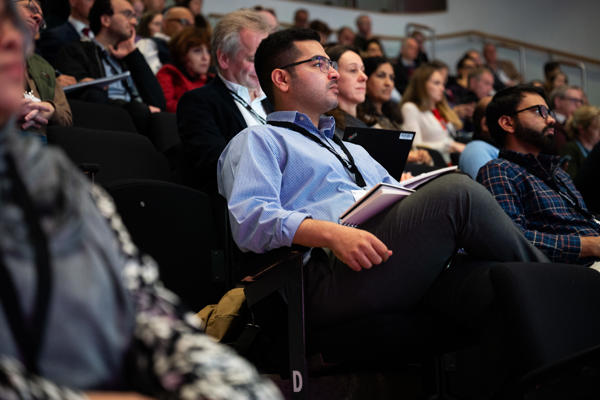As the current RCP exhibition ‘Scholar, courtier, magician: the lost library of John Dee’ continues, Liam Sims from Cambridge University Library describes some books written by Dee now to be found in libraries in Cambridge. This is part of series of guest posts.
As the RCP exhibition shows, part of Dee’s own library was dispersed in his lifetime, and many of his books are now to be found in Cambridge, including a handful at St John’s College and a good number – including four incunabula (books published before 1501, all of which came in 1664 from the library of Richard Holdsworth) – at the University Library. Trinity College even boasts a handwritten catalogue of Dee’s library (which may have contained as many as 4,000 volumes), made in 1583, and given to the college in the eighteenth century. In this post, however, I would like to discuss a copy of one of Dee’s own works which sheds some light on his time in Cambridge and on other great libraries of his day.
Dee’s family had royal connections – his father Rowland was a ‘gentleman-sewer’ to Henry VII – and in 1542 he was admitted at the royal foundation of St John’s College Cambridge, founded only thirty years earlier by Lady Margaret Beaufort, Henry VII’s mother. In 1546 he became one of the founding fellows of Henry VIII’s new Trinity College, where he would earn his reputation as something of a conjuror: in the late 1540s he created stage effects for a performance of Aristophanes’ Peace in the college, which left the spectators thrilled.

The college’s great Wren Library contains a number of books formerly in Dee’s possession as well as some of his writings and one of these – his General and rare memorials pertayning to the arte of navigation (London, 1577) – made its way into the University Library’s collections in the nineteenth century, where it is now at the shelfmark Sel.2.82. The first book to use the term ‘British empire’ it called, in the context of Elizabethan seafaring, for the creation of a ‘Pety-Navy-Royall’, which might secure England’s growing colonial interests. Dee himself had a stake in the country’s dominance of the seas: he invested in the voyages of Martin Frobisher in 1576–7, during which Baffin Island (now part of Canada) was discovered, and where five of his men were taken captive by the local Inuit. The book was dedicated to Christopher Hatton, Lord Chancellor from 1587 and one of Elizabeth's closest advisors, who co-funded Drake’s circumnavigation voyage of 1577–80.

The copy now in the University Library contains much information about its former owners and would appear to have been in Cambridge for some considerable time. The margins contain many notes in a contemporary English hand, along with delightful manicules (pointing hands added in manuscript alongside interesting passages of text). The earliest recorded owner of this copy, who inscribed his name at the foot of the title page, was John Lumley, 1st Baron Lumley (c.1533–1609) – aristocrat and custodian of the vast Nonsuch Palace between 1580 and 1592 – who was one of the greatest collectors of books and art of his day. His library contained about 3000 volumes when it was catalogued in 1596, which made it one of the most sizeable private collections in existence (the University Library had fewer than 450 volumes in 1583).
Upon Lumley’s death in 1609, many of his books were acquired by Henry, Prince of Wales (son and heir of James I and elder brother of the later Charles I) – then aged just 15 – whose appetite for books was voracious. Widely regarded as intellectually and culturally superior to his brother, Henry was a popular heir to the throne, surrounding himself with music and devoting himself to study. But his own death, aged eighteen, in 1612, sent the nation into deep mourning and would later put Charles on the throne in his place.
This volume, however, passed into the collection of Sir Henry Puckering (1618–1701) – the head of the title page is inscribed ‘HP’ – whose father (Sir Adam Newton) had been Prince Henry’s tutor. Sir Henry’s gift of books to Trinity in the years after 1691 – just a few years before the completion of the new Wren Library – included autograph manuscripts by Milton and a notebook kept by the young Prince Henry. This copy of Dee’s General and rare memorials bears a mid-eighteenth-century Trinity College bookplate, signed by its engraver – William Stephens – who worked in Cambridge between 1736 and 1760.

By 1829 a finer copy (hand coloured) had evidently entered the Wren Library, and in that year the second copy was presented as a duplicate to the University Library, which did not then have one. An inscription inside, presumably by a member of library staff at Trinity, reads ‘This book is by the famous Dr John Dee … there is another finer copy than this in the Library…’. This volume, with its marginal annotations and illustrious former owners, is a valuable relic of and pointer to Dee’s wide interests and involvement in English public life during the reign of Elizabeth I and the University Library is lucky to be its custodian.
Liam Sims, Rare Books department, Cambridge University Library
- ‘Scholar, courtier, magician: the lost library of John Dee’ runs until Thursday 28 July 2016.
- Read more about our collections on our weekly blog, and follow @RCPmuseum on Twitter and @rcpmuseum on Instagram.



